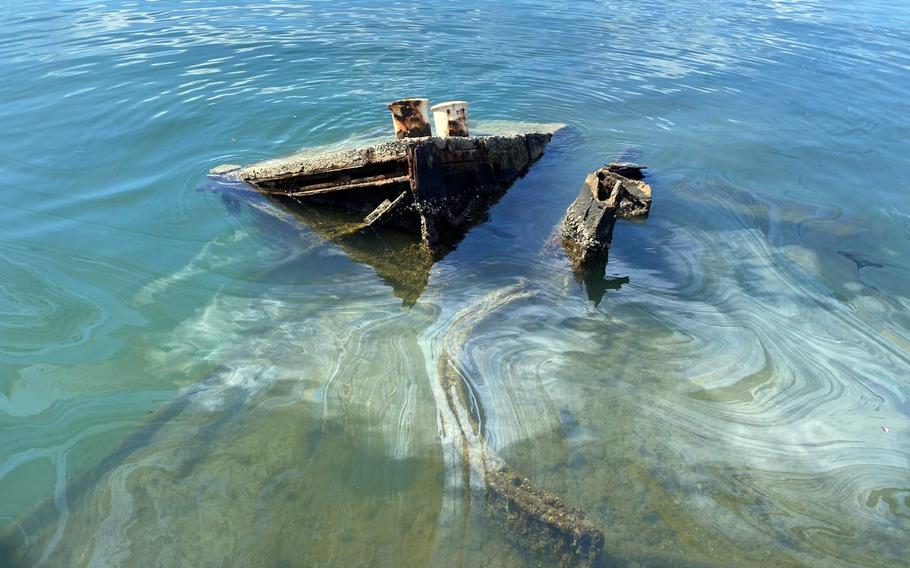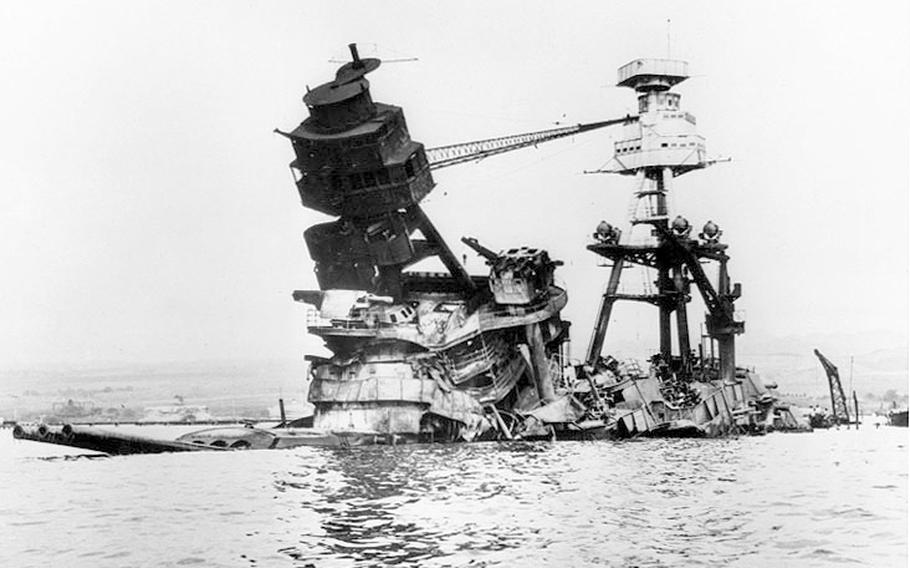
In late October, staff with the Pearl Harbor National Memorial discovered that a concrete-steel platform used for salvaging the USS Arizona during World War II had partially collapsed. (GiGi Kaestner/National Park Service)
FORT SHAFTER, Hawaii — It took Japanese torpedo bombers less than an hour to sink the battleship USS Arizona during the Dec. 7, 1941, surprise attack on Pearl Harbor.
Salvaging the unrepairable hulk that rested half submerged on the harbor floor took almost two years. A pair of platforms were welded to the sides of the Arizona to which ferries, barges and ships tethered as workers stripped parts critical to the war effort.
Now, after eight decades of exposure to salt water and ever-pressing tides, one of those submerged platforms has collapsed after breaking loose from the ship, which is now part of the USS Arizona Memorial.
On Oct. 27, staff with the Pearl Harbor National Memorial discovered the smaller of the two platforms had shifted, with its concrete surface now inclined diagonal in the water.
A preliminary assessment found that the platform appeared to be stable, but a much more in-depth evaluation will be needed to determine what can or should be done to preserve it, David Kilton, a spokesman for the Pearl Harbor National Memorial, told Stars and Stripes by phone Wednesday.
Preserving both platforms is essential to historical preservation, he said.
“Our mission at the National Park Service is not just Dec. 7, 1941,” he said. “It’s the lead up to the attacks, the actual attack and the aftermath, continuing all the way to peace and reconciliation – a story still playing out today.”
“Those platforms tell the part of the story of the salvage,” he said.

The USS Arizona rests submerged in Pearl Harbor, Hawaii, shortly after the Japanese surprise attack on Dec. 7, 1941. (U.S. Navy)
The top of the now-listing platform is a roughly 2-by-6-foot concrete slab, about a foot thick, Kilton said. It is lined with bollards that had been used to secure vessels.
The slab is attached to a submerged steel frame that had been welded to the ship.
The Arizona was one of only three ships so badly damaged in the attack that they were unrepairable, Kilton said.
The wreck of the USS Utah remains in the harbor, and a memorial was erected near the site in 1972. At the time it was sunk, the Utah was no longer an active battleship and was used primarily for anti-aircraft training.
The battleship USS Oklahoma underwent salvage work until 1946, when a private company purchased the Oklahoma’s hull and attempted to pull it by tug to California. The battleship sank about 500 miles east of Hawaii.
The sunken wreck of the Arizona is the centerpiece of the Pearl Harbor National Memorial. Roughly 1.7 million visitors each year take the short ferry trip to the memorial’s viewing platform that was erected above the sunken hull. The area includes a shrine room listing the names of the 1,177 crew members who died because of the attack.
The memorial’s dive team is working with the Navy and a dive resource team from the National Park Service’s Denver Service Center to conduct a more thorough assessment of the platform’s condition, Kilton said.